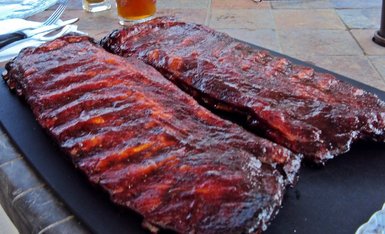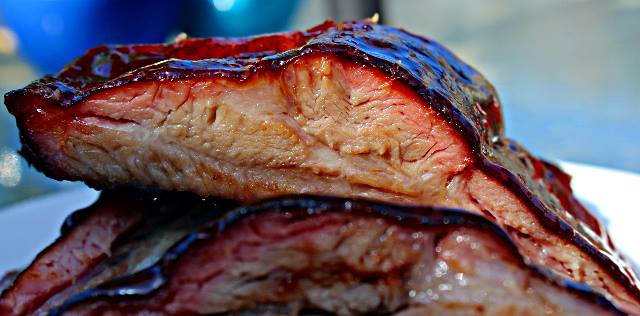How to Barbecue Ribs
Hello!
Welcome to How to Barbecue Ribs 101.
In this course, I will give you a brief overview of ribs.
Then we will discuss;
- How to select the tastiest ribs.
- How to prep and season ribs.
- How to barbecue ribs.
When you finish this course, you'll know how to make fantastic ribs that you can have whenever you want!
Ribs are loved by everyone!
Why?
Maybe it's the primal act of gnawing meat off of a bone, making us feel a little like cavemen.
Or the love of cooking juicy, delicious meat over a fire.
Maybe it's the sweet, smoky taste of the meat after being seasoned and cooked to perfection. The delight of flavors is experienced as you lick the juice off your fingers.
Whatever it is...Most people would agree...
Ribs are great!
Great-Tasting Ribs
Ribs are indeed fantastic...When cooked right.
Ever had a lousy rib?
We all have, unfortunately. They're horrible! Dry, grainy, and chewy. Yuck!!!
Words you definitely DON'T WANT to be associated with your ribs. And they never will be, as long as you follow the techniques outlined in this how to barbecue ribs course.
But before we get into how to barbecue ribs, let's look at what goes wrong...
The most common mistake is an incorrect cooking method. You may be asking yourself...What does that mean? It means cooking them the wrong way.
A tragedy, to say the least!
Ribs are a unique cut of meat; they are thin, which means, theoretically, they can be cooked to a safe temperature relatively quickly. But there's a problem with that technique...
You see, ribs contain large amounts of connective tissue and fat, with some meat surrounding many bones. A unique culinary challenge that this how to barbecue ribs course will address.
Even though the meat is thin, it should be slowly cooked to achieve the best flavor and texture.
Cooking ribs quickly does not break down the connective tissue and renders the fat too quickly. The result is a dry, chewy, tasteless piece of meat.
How to alleviate this problem?
Read on...
How to Get the Best Results
The first and most crucial lesson in this course about how to barbecue ribs is your ribs' quality. Because it doesn't matter;
They cannot make a bad cut of meat better than it's meant to be.
Let's talk about choosing ribs before talking about proper cooking techniques.
How to Pick the Best Ribs For Your Barbecue
The ribs used in this course on how to barbecue ribs are pork spareribs. Many of the same principles apply to baby back ribs and even beef ribs.
Here are the essential points to remember about rib selection;
- More meat is better than less, obviously, so select the meatiest racks you can find. No bones should be showing through the flesh. Usually not a problem with pork, but it can sometimes be a challenge with beef.
- Intramuscular fat is a large contributor to the meat's flavor and moisture, so choose cuts with the most marbling.
Also, choose ribs that have a nice, pink, fleshy color. No dark or gray meat, please.
- The meat should smell fresh and have little or no odor. (See the note below.)
- Choose slabs that are about three pounds each. The cooking time for these ribs, using the barbecue method, is four to six hours, depending on your cooking temperature. If you cannot find ribs in this size, select slabs that are all about the same weight so that they will all be done simultaneously. Make sure you adjust your cooking time to make up for the difference.
Note: Cryovac ribs may have a smell to them.This is a result of the Cryovac process.
Cryovac meats are actually "wet-aged" because of the Cryovac process.
This process purges oxygen from the container that the food is stored in and replaces it with nitrogen.
These foods keep much longer and are usually held for a very brief period before being sold. This period is the "wet-aging" period and does add some flavor to the meat.
What if you smell an odor?
If it goes away after a few minutes, the ribs are safe for your barbecue enjoyment.
Cooking Technique
Now let's get down to the our cooking technique.
We will be using the barbecue method to cook these ribs. After all, this is a course on how to barbecue ribs.
The second most important factor, after selection, is the proper cooking technique.
No matter how beautiful your rack is, your dish will never realize its full potential if cooked improperly.
Because of the connective tissue and the fat in ribs, they should be cooked low and slow.
That is how to barbecue ribs that are moist and tender.
They cannot be blasted with heat, and boiling them should never even be considered.
No self-respecting pit master would direct grill or boil a beautiful rack of ribs! His barbecue ribs would not employ either one of these methods.
So how should they be cooked?
With hardwood smoke, at a low temperature, for a long time.
In barbecue terms, low and slow.
Why?
- Because this method breaks down the connective tissue, making the meat incredibly tender.
- It renders the fat slowly, making the exterior nice and crisp while the inside is moist and juicy.
- The lower cooking temperature means that the ribs will be in that delicious hardwood smoke for quite some time. This will give it that smoky, barbecue flavor we all love.
Recipe - How to Barbecue Ribs
Note: You can use more or less rub, depending on your tastes.
More rub will make your ribs sweeter and spicier. Less will, of course, make them less sweet and spicy.
I suggest using the recommended amount to start with and adjust from there if you feel the need to do so.
You can keep notes of the amounts you use to customize and then consistently recreate your very own barbecue ribs recipe.
You can use the sauce for basting if you like, serve it on the side, or not use any at all. No sauce would be known as "dry ribs." If you are basting that beautiful rack, you'd be making "wet ribs."
- 2 Racks pork spare ribs
- 1 Cup barbecue rub
- Barbecue mop (optional, see the page on mops)
- 1 cup barbecue sauce. Kansas City Barbecue Sauce or my Easy Barbecue Sauce would be good choices.
- The night before your barbecue, apply 1/2 cup of the rub to the ribs, reserving the remaining 1/2 cup for the mop if you're using one. Place the racks in a large food-safe bag, or wrap them in plastic wrap and refrigerate overnight.
- Prepare your smoker for cooking, bringing the temperature up to 250°F.
- Place the meat in your smoker and cook for about 3 1/2 hours. Cooking time will depend on the size of your ribs and the temperature of your smoker. Baste the ribs every hour and a half if you are using a mop.
- After about 3 1/2 hours, remove the ribs from the smoker and wrap them in aluminum foil. Return them to the smoker and cook for another hour or so. The ribs are done when the rack feels "jiggly," which is the best way to describe it. When you hold the rack of ribs, it should bend slightly at about a 45° angle. You don't want the end of the ribs pointing down; this is overdone. Eventually, you will get a feel for this. It's much easier and quicker than unwrapping the ribs, especially if you're cooking many racks. You can also check by pulling two bones in the center of the ribs and spreading them apart. If the meat pulls apart easily, the ribs are done. Do not overcook! The ribs will be dry.
- Remove them from the foil and brush them with some sauce, if desired. Cook for about another half hour, turning once. Remember, though, always use a warm sauce. Putting something cold from your refrigerator on your meat will lower the temperature of whatever you're cooking. This means it will take you longer to serve your guests and cost you more time and fuel.
- When the ribs are done, remove them from your barbecue. If serving dry ribs, sprinkle the ribs lightly with some of the barbecue rub. Let the ribs rest for 10-15 minutes. Slice between the bones. Serve with some barbecue sauce if desired.
- Enjoy!
 Barbecue Ribs
Barbecue RibsRecipe Talk.
Be a Barbecue Know-Hower!
Do you have a question or comment about this recipe? Enter it below.
Have you've tried this recipe? Give us your review on it.
You'll be helping everyone who reads this page. And who knows, you may become famous!

